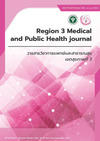The Effects of a Smoking Cessation Program Among Patients with Pre–Operative Head and Neck Tumor
Keywords:
Preoperative smoking cessation promotion program, head and neck tumors, smoking cessation, nicotine addictionAbstract
Objective: To study the effects of a preoperative smoking cessation promotion program in patients with head and neck tumors.
Method: The research was conducted through a quasi-experimental with a one-group pre-posttest design. The program took at least three weeks before the operation (preoperative period) and after the operation (postoperative follow-up) for six months. The research instruments were a preoperative smoking cessation promotion program in patients with head and neck tumors and a questionnaire about the perception of smoking-related diseases, the severity of nicotine addiction degree, preoperative smoking cessation behavior, and smoking cessation. Cohen’s formula was used for sample size calculation. G*power was used to calculate the power of the test, which was 0.98, and the effect size was 0.87. The samples of 30 persons were selected by purposive sampling method from October 2021 to March 2023 at Sawanpracharak Hospital, Nakhon Sawan province. Descriptive statistics were used for data analysis and comparison statistics. Nonparametric (Wilcoxon Signed Ranks Test was used to analyze the difference scores between before and after participating in the program.
Results: Participants significantly perceived (p-value <0.01) smoking-related diseases, including perception of the severity of smoking on the occurrence of the diseases, perception of risk and severity of complications during and after surgery, and perceived self-efficacy in quitting smoking. However, it was found that the expectation of smoking-cessation-awareness-score levels were higher than before participating in the program but not statistically significant, p-value=0.601. Concerning the behavior, the severity of nicotine addiction was statistically significantly lower than before participating in the program, p-value<0.01. Twenty-seven persons (90%) quit smoking before the surgery. Sixteen persons (53.3%) quit smoking more than two weeks, 24 persons (80%) stopped smoking consecutively for one month, 23 persons (76.7%) stopped smoking consecutively for three months, and 25 persons (83.3%) stopped smoking consecutively for six months.
Conclusion: The preoperative smoking cessation promotion program in patients with head and neck tumors enabled patients who had smoking habits to quit smoking before the surgery. The program helped reduce the severity of nicotine addiction. It was also found that the patients quit smoking consecutively after the surgery. However, a postoperative follow-up is required, including the return of information and creating continuous participation among caregivers, to reduce complications and cost burdens for patients, patients’ families, and healthcare system providers.
Keywords: Preoperative smoking cessation promotion program, head and neck tumors, smoking cessation, nicotine addiction.
References
Carrick MA, Robson JM, Thomas C. Smoking and anesthesia. BJA Educ. 2019; 19 (1): 1-6. [cited on 22 May 2021]. Available from:https://so03.tci- thaijo.org/index.php/human/article/download/176020/ 159271/786501
บุษกร รักสวย. ผลกระทบของบุหรี่เมื่อเข้ารับการระงับความรู้สึก. วิสัญญีวิทยาน่ารู้. ศูนย์แพทย์ศึกษาชั้นคลินิก. มหาวิทยาลัยนเรศวร; 2560.
World Health Organization Tobacco; 2020. [cited on 31 May 2021]. Available from: https://www.who.int/news-room/fact-sheets/detail/tobacco
Adinat U, & Sukrit K. Smoking and risk of negative outcomes among covid 19 patient: A systematic review and meta-analysis; 2021. [cited on 31 May 2021]. Available from: doi: 10.18332/tid/132411; DOI-PMC
ประกิต วาทีสาธกกิจ. ข้อมูลบุหรี่กับสุขภาพ. กรุงเทพฯ: ฑีรกานต์กราฟฟิค; 2560.
Bundhamcharoen K, Aungkulanon S, Makka N, Shibuya K. Economic burden from smokingrelated diseases in Thailand. Tob Control. 2016 Sep; 25(5) : 532-37.
Yousefzadeh A, Chung F, Wong DT. Smoking cessation: The role of the anesthesiologist. Anesth Analg. 2016; 122 (5):1311-20.
Wong J, An D, Urman RD. Society for Perioperative Assessment and Quality Improvement (SPAQI) consensus statement on perioperative smoking cessation. Anesth Analg. 2020; 131(3): 955-68.
Ferlay J, Bray F, Soerjomataram I, Siegel R L, Torre L A, Jemal A. Estimating the global cancer incidence and mortality in 2018: GLOBOCAN sources and methods. Int. J. Cancer. 2019; 144, 1941–53
Lin H, Chen M, Yun Q, Zhang L, Chang C. Protection motivation theory and smoking quitting intention: findings based on structural equation modelling and mediation analysis. BMC Public Health. 2022; 22:838 https://doi.org/10.1186/s12889-022-13263-0
Rogers C. Cognitive and physiological processes in fear appeals and attitude change : A revised theory of protection motivation. In Cacioppo & R. Petty (Eds.), Social psychophysiology. New York: Guilford Press. (1983).
Faul F, Erdfelder E, Lang A.G, & Buchner A. G*Power 3: A flexible statistical power analysis program for the social, behavioral, and biomedical sciences. Behavior Research Methods 2007; 39: 175-91.
ธนะวัฒน์ รวมสุก สุรินธร กลัมพากร และทัศนีย์ รวิวรกุล. ผลของโปรแกรมช่วยเลิกบุหรี่โดยประยุกต์ใช้ทฤษฎีแรงจูงใจเพื่อป้องกันโรคในผู้ป่วยโรคความดันโลหิตสูง. วารสารพยาบาลปี 2561; 67(1): 1-10.
Anderson G.Tobacco Cessation: A Quality Improvement Project Using the 5 A’s. Model. [degree of Doctor of Nursing Practice] Kansas City: University of Kansas School of Nursing; 2017. [cited on 31 May 2021]. Available from: https://kuscholarworks.ku.edu/bitstream/handle/1808/26920/Anderson_ku_0099D_ 15639_DATA_1.pdf?sequence=1&isAllowed=y
คอลิด ครุนันท์. ผลของโปรแกรมการปรับเปลี่ยนพฤติกรรมที่บูรณาการสมรรถนะแห่งตนในการเลิกบุหรี่ต่อพฤติกรรมและสมรรถนะแห่งตนในการเลิกบุหรี่ของผู้ป่วยปอดอุดกั้นเรื้อรัง. [วิทยานิพนธ์ ปริญญาพยาบาลศาสตร์มหาบัณฑิต]. ชลบุรี: พยาบาลศาสตร์ มหาวิทยาลัยบูรพา; 2559.
Fagerstrom K. Derminants of tobacco use and renaming the FTND to the Fagerstrom test for Cigarette Dependence. Nicotine Tob Res. 2012; 14(1): 75-78.Doi:10. 1093/ntr137
นวลจันทร์ ดิเรกวุฒิกุล. การประยุกต์ทฤษฎีแรงจูงใจเพื่อป้องกันโรคในการเตรียมผู้สูบบุหรี่ให้พร้อมก่อนผ่าตัด. สวรรค์ประชารักษ์เวชสาร 2555; 9(2): 62-70.
Chalermburanawong J, Preechawong S. Effect of the motivation program to quit smoking in Royal Thai Air Force officers with non-communicable disease risks. Journal of Health Research 2019; 33(5). 416 – 424.
นวลขนิษฐ์ ลิขิตลือชา, สุปราณี อัทธเสรี. แนวปฏิบัติการพยาบาลเพื่อช่วยเลิกบุหรี่สำหรับวิสัญญีพยาบาล. เครือข่ายพยาบาลเพื่อการควบคุมยาสูบแห่งประเทศไทย สมาคมพยาบาลแห่งประเทศ ไทย. นนทบุรี: สำนักพิมพ์สื่อตะวัน; 2565.
Downloads
Published
How to Cite
Issue
Section
License
Copyright (c) 2023 Region 3 Medical and Public Health Journal - วารสารวิชาการแพทย์และสาธารณสุข เขตสุขภาพที่ 3

This work is licensed under a Creative Commons Attribution-NonCommercial-NoDerivatives 4.0 International License.



